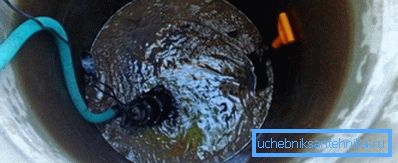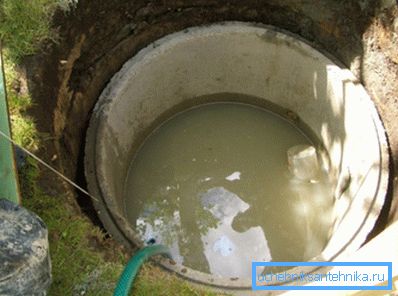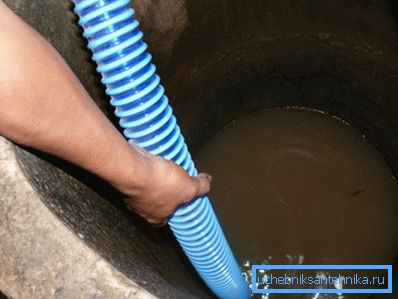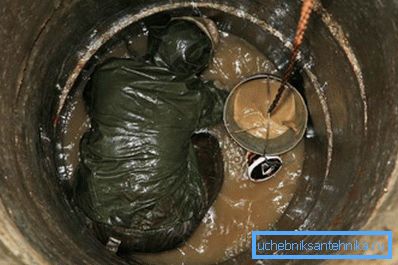Pump for cleaning the well: drainage silted source
During operation, any water source is gradually silted up. It is for this reason that the systematic cleaning of the well by means of a pump with the preliminary excavation of bulky waste is so urgent.
Regularly performing these operations, we will be able to significantly improve the quality of well water, as well as extend the service life at least twice.

Signs of pollution
Before you select a pump for cleaning wells, it is necessary to determine the time to perform the work. As a rule, our compatriots start the removal of silt and dirt only when the water practically disappears - that is, much later than it should.

There are several signs indicating the need for prevention:
- First, the water level drops significantly.
Note! Here we are talking about a steady decrease, rather than a change in the level of the aquifer with summer droughts or regular selection of large volumes.
- Secondly, clay particles appear in the water. Most often this occurs due to the penetration of surface water.
- Thirdly, cleaning is needed when littering the well. Usually branches and leaves act as garbage, but sometimes it is necessary to remove foreign objects thrown by “well-wishers”.
- Also, reasons for “general cleaning” include changes in water quality: turbidity, the appearance of an unpleasant taste, odor, etc. In most cases, this is due to poor quality of the bottom filter of the well, however, the reason may be flooding with fecal water, depressurization of joints between concrete rings, etc.
Anyway, if any of these signs appear, it is necessary to take urgent measures.
Cleaning technology
Equipment
To perform a thorough cleaning, we need to first process the walls and the bottom with special tools, and then pump the suspended particles.
Consequently, the list of equipment will include:
- Ladder (normal or rope), on which we will go down into the well.
- Safety belt to which the cable or sturdy rope must be tied.
- Bucket and brush for processing walls.
However, the main element of our equipment will, of course, be a mud pump for cleaning wells:
- In order for the work to be done as qualitatively as possible, we should use a drainage pump. It is these devices that have a design that allows water with a large number of solid inclusions to pass through the flow part.
- The advantage must be given to centrifugal mechanisms. Vibration models are good when working with clean water, but when hit by bottom sludge and dirt, they quickly break them down.
- With regard to specific brands, experts recommend the use of pumps from the company ESPA, portable drainage installation "Gnome", "Dzhileks", "Kachok" and similar.

- If the cost of the drainage pump seems too high, then you can use a submersible device instead ("Spring" or similar). But in this case, it is necessary to pre-remove the bulk of the sludge manually or with the help of a sludge, otherwise the mechanism will fail very quickly.
- The power of the apparatus must correspond to the depth. It is not worth saving: the use of a low-powered pump will only lead to the fact that we pump out only the water, almost without capturing silt, sand and clay. (See also the article How to choose a pump for a well: selection criteria.)
Preparatory work
Before the pumping of the well is started, a number of preparatory work must be carried out:

- We pump out or scoop out buckets of water so that its level drops to at least half.
- Inside the well set the stairs. Moving on it, with the help of a brush we process all the walls.
Note! The use of detergents and other chemical reagents is not allowed!
- If necessary, with our own hands we perform sealing of the seams, sealing them with cement mortar or other sealants. The main thing is that after polymerization, the composition is water resistant.
- You can also treat the walls with a solution of bleach. After this treatment, hermetically close the lid for at least 48 hours, and then - twice we pump out the water to completely remove the reagents.

Also when performing work it is necessary to strictly follow the safety regulations. Before you go under the ground, you should wear a respirator or gas mask (cases of poisoning due to gas are not uncommon), and on the surface you must be insured by an assistant.
Note! Doing such work alone is prohibited!
Fluid pumping
Instructions for using a drainage pump are also quite simple:
- In the well, which was previously cleaned by the above algorithm, we lower the pump. In most cases, the water intake hole is located at a distance of about 0.5 - 1 m from the bottom.
- We turn on the pump at full capacity, ensuring that along with the water it captures silt and sand.

- The pumped water is passed through a sand-catching filter (a barrel with two taps, at the bottom of which suspended particles settle), then we drop it back into the well. (See also the article Features of the filter well.)
- This is done so that the flow of water raises as much as possible of oozy particles from the bottom.
- Periodically clean the sand trap. When it stops accumulating sediment, you can stop the reverse discharge of water.

- During operation, any pumps for cleaning wells must be periodically lifted to the surface and washed with water. This helps to remove deposits that can cause overheating and breakdown of the mechanism.
Conclusion
When choosing which pump to clean the well with, it is necessary to give preference to the models specially designed for this purpose, namely the drainage pumps.
The use of properly selected equipment and high-quality preparatory work will provide the desired result. So after pumping silt and sand, the water at the source will remain clean and clear for a long time. More details on the choice and use of the pump are covered in the video in this article, so we recommend that you study it very carefully.